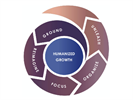Maja Pawinska Sims 29 Sep 2020 // 10:25AM GMT

The third wave of PRovoke Media’s research into the impact of Covid-19 on the global PR industry found that 59% of agency heads around the world expected less than half of their staff to be working from the office by the end of 2020.
Most respondents said, perhaps not surprisingly, that the optimum ratio was an equal balance of working from home and working from the office.
To supplement the findings with some more qualitative analysis, PRovoke Media followed up the research by talking to agency leaders in North America, EMEA and Asia-Pacific on their plans, and how they are now balancing returning to the office and working from home, excerpted below.
The picture is as different – and constantly evolving – country-by-country as you might imagine, given the original geographic spread of the virus and significant variation in approaches to its management and lockdown by individual governments.
In the UK, for example, after weeks of being encouraged back to the office and to eat out again, prime minister Boris Johnson’s response to cases of Covid-19 rising sharply was to issue new guidance last week that people should in fact work from home wherever possible.
This has interrupted the significant logistical work that agency leaders in London and beyond had put towards reopening offices safely for those who wanted to return. The move has dismayed many, with one of the chief concerns being employees’ mental health, particularly younger team members who may not be in ideal working environments at home and are missing human interaction. Others in the UK industry say they are relieved to have clearer guidance again to simply work from home where possible.
The PR industry has proved to be remarkably resilient in many ways this year, and pivoting virtually overnight to an entirely virtual agency model has been an astonishing achievement. There are many aspects to achieving a sustainable and productive hybrid between working in the office and working from home – or living at work, as it has been expressed.
One thing is clear: whatever the details of the approach agency leaders choose to – or are forced to – take, we are not likely to see a full return to the office anytime soon, anywhere in the world.
North America
Mike Doyle, president and CEO, Ketchum
“Moving to this fully remote environment hasn’t been easy for anyone, including us, but our people have adapted so well and really embraced the infrastructure and tools we have in place to enable them to do their jobs well and service their clients. We’ve taken a measured approach to our return to our physical workspaces, keeping our people’s well-being at the forefront and polling them a couple of times over the course of the summer to help us better understand their needs and their interest in returning to the office. Many of our U.S. people plan to work from home for the foreseeable future, but there is a small percentage of our staff who very much wanted to return to the office, so we officially reopened four of our offices after Labor Day.
“Many of our international offices have been open for some time, while our other U.S. offices are reopening at a later date as local guidelines and other considerations within their specific locations shift. Our offices are operating on a hoteling basis with socially distanced workstations through the end of this year, and we’ve been lucky in that our reopenings have been smooth and those that are coming in are not just compliant but appreciative of the safety measures we have in place. What I’ve been hearing from them is that being back in the office brings some semblance of normalcy in this very abnormal year.”
Greg Mondshein, co-founder and managing partner, SourceCode Communications
“We made the decision more than a month ago to not return to the office this year. We did a staff survey and more than two-thirds had concerns about going back to the office. We estimated that at most 15% of our team would return in any capacity if we opened. Considering the risk to our team and the added expense, the juice wasn’t worth the squeeze.
“Having said that, we’re confident that we will return in some capacity. There are members of the team that long for the office environment and in-person collaboration. Once we feel we have an appropriate plan to provide that option, we absolutely intend on doing so. There have also been some major learnings when it comes to working from home. First, onboarding new employees is totally doable while ensuring they feel our culture, even from home. Socially distanced events and activities can work and are a really nice experience for the team. Additionally, work/life balance has improved for much of the team.”
Alex Conant, founding partner, Firehouse Strategies
“Online video conferences are no substitute for the creativity that happens when a group of smart people get together in person. Since bringing the team back to the office, the improvement in morale, productivity and revenue came faster than we could have hoped. Most important, the staff is happy to be able to see each other again.”
Kim Sample, president, PR Council
“In the major metro markets, many of our agencies pushed their dates back to 2021. Those who have reopened and are presenting a choice are seeing very few staffers return. Hearing that input and surveying their own employees has made some leaders question if it’s worth the effort and cost to reopen before 2021. That said, many are committed to offering a choice to employees who have less than ideal set-ups at home. An HR leader at a large agency shared that they are reviewing all of the safety protocols and guidelines with employees and then plan to survey employees to ask if they want to return part-time or continue WFH. They want employees to have a full understanding of the new rules before saying they want to return.
“An issue that’s cropping up more and more are those employees who have decided to move to a different market than where their office is located. This isn’t a big deal for a large agency, especially those that are holding company owned – they’re already set up to have employees in most states. This could become an expensive hassle for smaller companies. Also, per your survey, leaders don’t believe 100% remote is the way to go.”
EMEA
Rachel Gilley, EMEA president, Clarity
“Our London team had been returning to the office since August, when we were operating a two team system in pods on different days with a deep clean in the middle of the week. The new Government guidance looked to scupper that, which was so disappointing. However, we talked to the team who were desperate to find a way to keep the office open in some form - something we'd been hearing other agencies and businesses were looking to do. As a result we've decided to keep the office open as a ‘working space’ for those for whom working from home has become incredibly difficult i.e. shocking wifi, multiple flat mates in one space and review it every two weeks. Their desire to come in is a personal choice, we are not asking them to and they all agreed they were happy to sign a waiver to confirm they understand that this is a personal decision.
“Had we not gone back already, this might have been a different outcome and we'd be in full WFH style. But we've experienced the social interaction, albeit social distanced, the agency banter and the camaraderie that we'd all missed so badly and any opportunity to hold on to it for a bit longer, for some is essential.”
Adrian Brady, chairman, Eulogy
“Back in March, as we became acclimatised (somewhat) to Covid-19 our focus was the health, safety and wellbeing of our team, all the time ensuring our clients receive the service they rightly expect. Fortunately, we were already set up for remote working and it did feel as if the fact we took our decision to work from home a week prior to the initial UK government announcement meant we were already in our stride. Later in the summer we had a gradual return to the office based on social distancing, no groups in small meeting rooms, deeper and frequent cleans and all based on government guidelines. But only for those who were comfortable to do so. For those visiting the office we operated a three-day week only open policy. We were conscious that different people have differing work needs and this flexible approach allowed everyone and each team to make a plan that worked for them.
“Of course, things change quickly with Covid and the announcement last week about working from home where possible has made us act again. With immediate effect, we are reverting to a 100% work from home policy. Our focus in the months ahead will be ensuring that this has no negative impact on our team. We already know that we can deliver great client service this way. The real sign of our success will be ensuring that, as well as this great service our teams offer, we in turn ensure all our team continue to develop and have the emotional and career support on a personal level we have all enjoyed in years gone by.”
Matt Buchanan, head of PR & Influence, Ogilvy UK
“In line with the government’s new guidance, we are asking our people to work remotely where possible. If they cannot complete a task from home or for personal reasons prefer to be in the office, they are welcome to go to the office. Most importantly we are continuing to support our people’s wellbeing by providing mental health resources through our partner platform, Unmind.”
Ruth Allchurch, UK managing director, WE Communications
“We have made the decision not to open the office in London before January at the earliest and even our meeting rooms have been shut to encourage home working for everyone’s ongoing safety. It is the only responsible thing to do. We have already proven that we can be as productive and as successful as a home working team as one that is office based. It is of course a massive disappointment that we can’t meet up face to face, but we have to safeguard our staff above all else.”
Mandy Sharp, founder and CEO, Tin Man
“We are advising staff to follow government guidelines and work from home as much as possible, however, for those who will struggle mentally with working from home indefinitely, we are considering keeping the office open in some capacity. It’s been amazing how important having human interaction and working in the office has become for us all.”
Simon John, Jin managing director, UK
"As a European boutique agency with offices in London, Paris, Berlin and New York, one of the biggest challenges is the lack of guideline consistency in each of our markets. Therefore being flexible has been crucial to ensure all teams are safe while keeping communication fluid and teams motivated. In Paris, we are continuing to welcome colleagues in the office, while in London we are asking employees to work from home when they can, in line with government advice. As our business already operates across different markets on a daily basis, we’re used to engaging remotely with each other. Our core values mean we trust our employees wherever they are to deliver the best work for our clients.”
Jonty Summers, managing director, Hanover Middle East
“We’ve run a pretty flexible ship over the summer months with both Dubai and Abu Dhabi offices fully working from home. Since August we’ve returned in limited numbers – a max of 30% – and are now running a rota system with project teams coordinating attendance. We are normally at 50% capacity in our Dubai office. We’ve always operated a highly flexible model around working location but our Middle East team came to a mutual decision that too much remote working does have an impact on some of the core culture and collaboration elements that make Hanover so successful.”
Asia Pacific
Lee Nugent, regional director APAC, Archetype
“In APAC, countries are at very different phases of the pandemic. For example, in China, things are close to being back to normal; or at least the new normal – and we are already mostly back to the office with the teams given flexibility to work from home when they want to. Whereas in India Covid-19 infections continue to accelerate, so our offices remain closed. Managing our people, keeping them safe and secure remains our number one issue – and any teammate who feels uncomfortable working in a re-opened office, or making the commute, will be given the freedom to work from home. As we re-open right across the region, we will move to a hybrid model – a mix of office and home-working for those who want to take up that option.
“Right now, we have around 35-40% of our APAC staff working from the office at least part of the week (enabling us to observe workplace distancing regulations), but with around half of our team based in India, where coronavirus remains rife, it may yet be a while before this number increases. Post-Covid, we expect to continue to evolve to an even wider hybrid working model, with a greater emphasis on personal choice. Our own staff feedback is telling us how much some appreciate avoiding a long commute – which can be 90 minutes each way in some countries – while others are desperate to fully re-connect with colleagues again. Given we have seen no real impact on productivity while we’ve been majority working from home, we know that the hybrid model can work for the business, for our clients and for our teams.”
Darren Burns, president, Asia Pacific, Golin
“In Taipei, Beijing, Hong Kong and Shanghai we’ve seen relatively minimal lockdowns (if any) so things are kind of the way they were before Covid, perhaps a tad more hybrid with most people working 80-100% from the office. I see it going forward as 80/20 – in some markets maybe 90/10 – however we’ve stated that people should work from home if they feel unsafe.
“In Singapore, WFH has essentially been in effect since March, so people now have adapted to that. ‘How do we lure people back to the office’ is a common dinner conversation these days. We are definitely exploring what the office of the future actually means: it may be more like a community hub. We are exploring this now with our people through surveys and discussions. It’s a great chance for us to really move into the 21st century and away from the old industrial age office model. Remember this forced experiment is only really six months old so we have lots of research to do.”
Additional reporting by Arun Sudhaman and Diana Marszalek.


































.jpg)

















